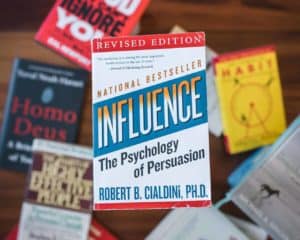Use Storytelling for a Better Blog

In ancient times, a powerful king oppressed his people. The citizens of the land feared the king and begged the gods for help. So the gods created a wild man that could equal the king and stop his misdeeds.
The wild man and the king fought a great battle, but the king showed superior strength. After all was over, the two men became friends and began a grand journey together that would see triumph, heartbreak, and the search for eternal life.
This is the Epic of Gilgamesh, the earliest surviving work of literature, written around 1800 BC.
Human beings are natural storytellers. We’ve been sharing tales around the campfire since the invention of the campfire! Even ancient cave paintings from 30,000 years ago tell stories of the hunt.
So what does the Epic of Gilgamesh have to do with blogging?
Turns out, a lot!
How Do Stories Draw in Readers?

Stories help your writing to stand out. In the unending ocean of blogs (over 500 million of them!), interesting stories share personality and entertain the readers. While they may be searching for answers to their problems, they also want to have a little fun!
Clever storytelling also helps the writer to connect to the reader. It shares your unique voice and displays your personality. Telling stories is how you can get people to look forward to your content eagerly, instead of reading a blog once and never coming back to your site.
One study showed that a blog post that opened with a story saw nearly 300% more readers scroll all the way to the bottom of the page. Since the call to action in a blog post is usually near the bottom, that’s 300% more people with a chance to convert!
One of the masters of blog storytelling is Laura Belgray of Talking Shrimp. She uses clever storytelling to draw in readers to her blogs and emails. She’s been featured in Business Insider, Fast Company, Money, and Forbes, and she uses the same storytelling techniques in these major publications.
Where Can You Find Stories?
From all around you!
Even simple, everyday events can be repurposed into interesting anecdotes that illustrate your point.
Laura Belgray once used a story of her search for basil for a recipe to demonstrate how important it is to build an online community. The story was funny and engaging. And while it wasn’t clear at first how it was going to relate to her final point, the eventual connection made perfect sense.
You may find that when you’re sitting down to write, you have a hard time coming up with a relevant anecdote. This is a common problem. That’s why it’s helpful to create a “story bank.”
Note the wins, failures, and funny events in your daily life. Then when you need a story for a new post, you can refer back to that bank to find an appropriate tale. These don’t have to be major, dramatic life events. A simple metaphor can be enough to draw in the reader.
Also — stories don’t have to be true!
Now, that doesn’t mean you should make up a case study or testimonial. Falsifying results is unethical marketing. But you could absolutely invent a story to illustrate a point.
For example, let’s say I wanted to write a post about businesses who don’t do their due diligence — who run headfirst into a new product or market, without doing their research.
To illustrate that point, I could share a story of my dog who barrels after her tennis ball while paying no heed to where she’s going — only to run face first into my fence!
Where Do Stories Fit In?

The best way to use storytelling in blogging is right at the top.
The purpose of your headline is to get people to start reading. And the purpose of your blog’s introduction is to get people to keep reading. So hook them with an introductory story.
The story should have a main character, a problem, an action, and a solution in order to be interesting for the reader. Remember that without a problem, there’s no story!
After you’ve told your story, you’ll need to transition into the rest of the blog post. A smooth transition will make it easier for the reader to flow from the introduction into the rest of the piece. Your transition should connect the two, making it clear why your story aligns with the article’s message.
You may want to use a transitional phrase like, “What does this have to do with ____?” or “Why does this matter? Because…”
You can also split your story between the introduction and the conclusion of the post. Introduce your main character and their problem at the top of the blog post. Then get into the “meat” of the article, explaining ways to resolve it.
In the conclusion, return to your story. Share the action the character took to solve their problem (using one of the methods you explained), and how that action led to a solution.
Practice the Craft
Storytelling takes practice, and it will take some time before you have a robust story bank to pull from. But start putting one idea in the bank daily, and soon you’ll have a wide variety of options.
Try adding stories to some of your old blog posts to see if the reader’s time on page increases. You might be surprised by what you find!






